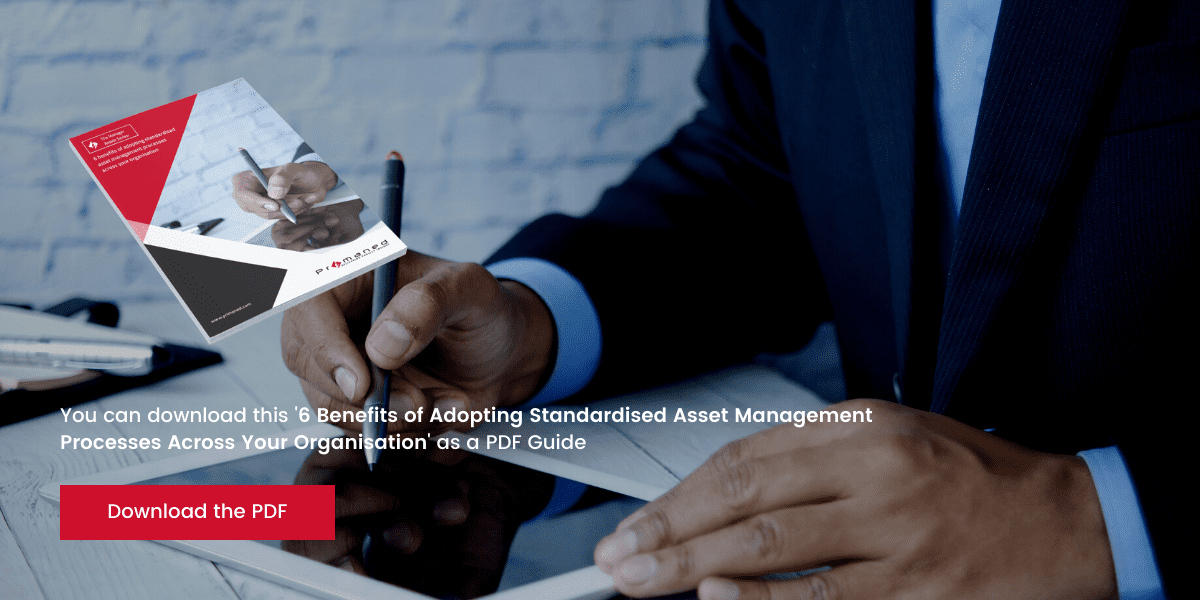6 benefits of adopting standardised asset management processes across your organisation
By Sjef van Vugt on May 19, 2022 11:00:00 AM

6 Benefits of Adopting Standardised Asset Management Processes Across Your Organisation
While a corporate real estate management software solution can achieve many things, its ultimate power lies in its ability to help CRE leaders standardise processes.
Standardised asset management processes are a set of consistent, controlled ways of working that are followed across the organisation. Essentially, it’s a way to get everyone, from every department, using the same compatible methods.
But what are the benefits of standardisation? Below, we take a closer look at six benefits of adopting standardised asset management processes at work:
1. Improved Performance
If you’re handling thousands of buildings, managing them all differently depending on what the client wants and what stage they’re in is probably going to end up being a massive headache for you and your team. Chopping and changing how you work depending on the project means it’s very likely that mistakes will be made somewhere along the line, limiting your success. When there’s a standardised process that forms the foundation of every project, it’s harder to overlook things because there’s a path from start to finish. It drives performance and productivity.
2. Better Decision Making
When everyone works in the same way, they handle their data in the same way, too. This makes it easy to build a centralised data system and, perhaps even more importantly, for CRE teams and all stakeholders to truly leverage the information they hold to make smarter, better, more effective decisions for the future of their projects. And when all stakeholders have access to the same data, at the same time, collaboration is much improved. It invites discussion and welcomes conversation to ensure all perspectives are taken into account before a decision is made.
3. Reduced Wastage
When you have to re-invent processes for each new project depending on who the project is for, and which departments are involved, it can be a huge waste of both time and resources. When asset management processes are standardised, ways of working can be optimised to ensure the most effective and efficient use of resources, saving the business time and money. Standardisation helps to create a linear, clear, and transparent pathway from A to B so that everyone knows what needs to be done, and when, with fewer delays trying to figure out what’s next.
4. Improved Client Communications
Different clients all want different things; they all want to see different information about the status of projects, and they all want it presented in a different way. Client A wants data to look this way, client B wants data to look that way, and so on. When there’s no set process for how data is dealt with internally, it becomes incredibly difficult to adapt individual data sets into information that meets client needs. However, when internal data is all managed in the same way, using clear processes, it’s much easier for any department to find the right data, at the right time.
5. Improved Internal Communications
Collaboration has long been inhibited by internal silos. But today, with the widespread shift to remote working, teamwork is becoming more of a challenge. Today, it’s very common for businesses to take the easy route and adopt a ‘everyone do their own thing’ type of policy; a policy that states that it doesn’t really matter how a job is done, as long as it’s done. That’s a slippery slope. For effective communications across the organisation, people need to be working in the same way, seeing the same data, and shaping their methods using the same guidelines. An integral project management system bakes in that consistency across departments.
6. Ongoing Improvements
Quite simply, you can’t improve your processes if you don’t know what your processes are. When asset management processes are standardised, it becomes easier to see what’s happening and state with confidence that ‘this is how we’re doing things’. This creates a baseline upon which you can build, develop, and improve how the organisation works. Standardising and documenting processes enables you to visualise them, identify weaknesses and vulnerabilities, and adapt to ensure that you’re operating in a way that brings the most value to the business.
So… Why Are So Many CRE Leaders NOT Standardising?
It’s clear that standardising the asset management process can bring numerous advantages. So, what’s holding many CRE leaders back from making the change?
There are two obstacles to standardisation:
- The time and effort involved in implementing change
- The expertise that’s needed to implement change in the right way
Fortunately, an implementation partner can address both those challenges.
Remember: standardisation doesn’t mean forcing everyone to work in exactly the same way, 100% of the time. Some degree of flexibility will always be needed to manage each project in the best way. What it does mean, however, is that everyone working on a project is using project smart workflows and consistent best practices that are compatible with how different departments operate, helping to drive the best outcomes.
- OPC (15)
- Software (12)
- PC Boardroom (11)
- Academy (9)
- Consultancy (7)
- Manager Project Controls (6)
- IT / Procurement (5)
- Planning Engineer / Scheduler (5)
- Project/Assets Manager (4)
- Information Manager (3)
- BI & Data Analytics (2)
- C-level (2)
- Document Controller (2)
- Document Management (2)
- Oracle Aconex (2)
- Project Controls (2)
- Risk Manager (2)
- Scheduling Lead (2)
- Operational project staff (1)
- PMWeb (1)
- Resource Manager (1)
- Safran Risk (1)
Subscribe by email
You May Also Like
These Related Stories

The 3 Standard Processes and Skills Needed to Successfully Implement Forensic Planning
The 3 Standard Processes and Skills Needed to Successfully Implement Forensic Planning Let’s face it. Most project planning teams are filled with people who hav …
-1.png)
Dura Vermeer Becomes First Construction Company in The Netherlands to Enhance Processes Using Oracle Primavera Cloud
As many of us are starting to realise, construction projects are becoming increasingly complex. The challenges that we’ll face along the way are becoming more a …
-1.png)
The Manager Assets Series: How to standardise your real estate data to align your business processes into one asset project management system
The Manager Assets Series: How to Standardise Your Real Estate Data to Align Business Processes into One Asset Project Management System


